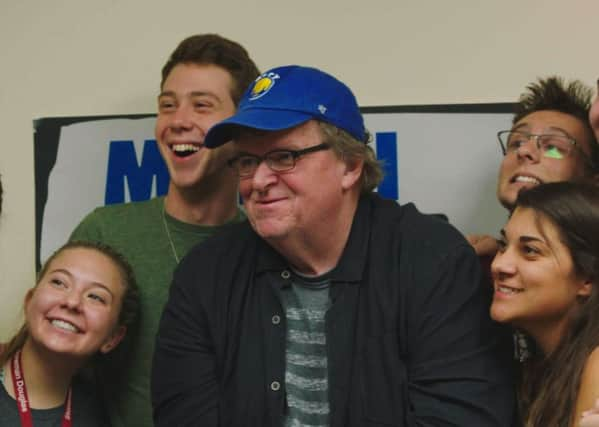Film reviews: Fahrenheit 11/9 | Halloween | Goosebumps 2: Haunted Halloween


Fahrenheit 11/9 (15) ***
Halloween (18) **
Goosebumps 2: Haunted Halloween (PG) ***
‘How. The. F***. Did. This. Happen?” So asks Michael Moore in the opening scenes of Fahrenheit 11/9, a sequel of sorts to his 2004 documentary Fahrenheit 9/11. That film, the most successful documentary of all time (it made more than $220m worldwide), detailed the link between the attack on the Twin Towers and George W Bush’s decision to go to war against Iraq. The titular date in the new one refers to Donald Trump’s surprise election victory on 9 November 2016, a result from which the world is still reeling, making Moore’s f-bomb-dropping question an urgent one.
It’s also a question Moore seems eminently qualified to answer. After all, he famously warned the Democrats that they “dismiss Trump at their peril” and he’s happy to remind us of this fact early in the film by showing clips of political commentators quoting him. His prophetic observation was based on a long-term understanding of the discontent voters have felt towards the political establishment. As a crusading filmmaker from the working class heartland of America, he’s witnessed and documented the pain of low-income workers, the marginalised and the voiceless for most of his career, starting with his hit documentary Roger and Me, about the plight of factory workers in his home town of Flint, Michigan.
Advertisement
Hide AdIt’s odd, then, and a little frustrating, that in attempting to answer the question he sets for the film, he never goes near a disgruntled white working-class Trump voter to get their perspective. Instead he adopts a scattershot approach that takes in everything from Trump “accidentally” throwing his hat into the ring for the presidential race as a ploy to get more money for doing The Apprentice (he was apparently annoyed that Gwen Stefani made more as a judge on The Voice) to the establishment biases of the liberal media and the failure of the Democrats to properly embrace and engage with the inherently left-leaning sensibilities of the American people.
The last of these is one of the most interesting aspects of the film and it’s where Moore’s talents as a muckraker in the noble tradition of Upton Sinclair and Lincoln Steffens are at their best, especially as he returns to Flint to explore the water crisis that saw the city’s supply contaminated with lead after the local government was subjected to what amounted to a corporate coup d’état. Moore sees this as a microcosm of what Trump is doing to America (a point Anthony Baxter’s You’ve Been Trumped Too also made), but he expands his view to take in issues like striking teachers, the upsurge in minority women running for local office, and the massive gun control rallies orchestrated by the Parkland school shooting survivors to show how grass-roots political movements like these might save the country. Of course the irony that this is also partly how Trump managed to assume power is not lost on Moore. In fact he draws sly parallels between himself and Trump, noting the jocular way their paths overlapped on a 1990s chat show – hosted by Roseanne Barr – and acknowledging his past professional relationships with both Jared Kushner and Steve Bannon, whose respective companies were involved in releasing some of his earlier movies. His own filmmaking style isn’t a million miles from Trump’s showboating either: again and again he batters us with cheap stunts (like cutting footage of a Nazi rally with audio from a Trump rally) and floods the film with conjecture and insinuations that he never feels any need to return to or back up.
The overall effect plays like a cinematic approximation of the chaos of the last two years. And yet the real question Moore seems to be hinting at, but never quite asking, is this: if Trump and the right can get away with using outrageous tactics to grab power, why can’t the left? The fact that Trump is in the White House and Moore’s film barely cracked the US box office top ten when it opened there last month perhaps tells its own story.
John Carpenter’s industry changing slasher classic Halloween turns 40 this month. Sadly the franchise, not to mention the sub-genre it inspired, is showing its age in this latest instalment. Once again starring Jamie Lee Curtis, Halloween is a sincere attempt by uber producer Jason Blum and indie director David Gordon Green to finally give Carpenter’s original a worthy sequel (it’s had many, all of them wretched). Despite eradicating many of its predecessors’ mythology expanding missteps and reimagining Curtis’s Laurie as a Sarah Connor-style survivalist who’s spent the last 40 years preparing herself (and her estranged daughter, played by Judy Greer) for the return of Michael Myers, it’s still not very good. Lacking tension, scares and coherent characters, it’s as hollow as a jack-o’-lantern.
Goosebumps 2: Haunted Halloween isn’t exactly a good horror movie for kids, but it’s a slight improvement on the original, largely because it sidelines Jack Black’s irritating presence as Goosebumps author RL Stine. This time out a pair of bullied 12-year-olds come across one of Stine’s unfinished manuscripts and unleash a ventriloquist dummy which comes to life in ways that are fun to start with but increasingly malevolent as it tries to take over their town. It descends into CGI overload for the finale, but there are some decent gags early on. ■